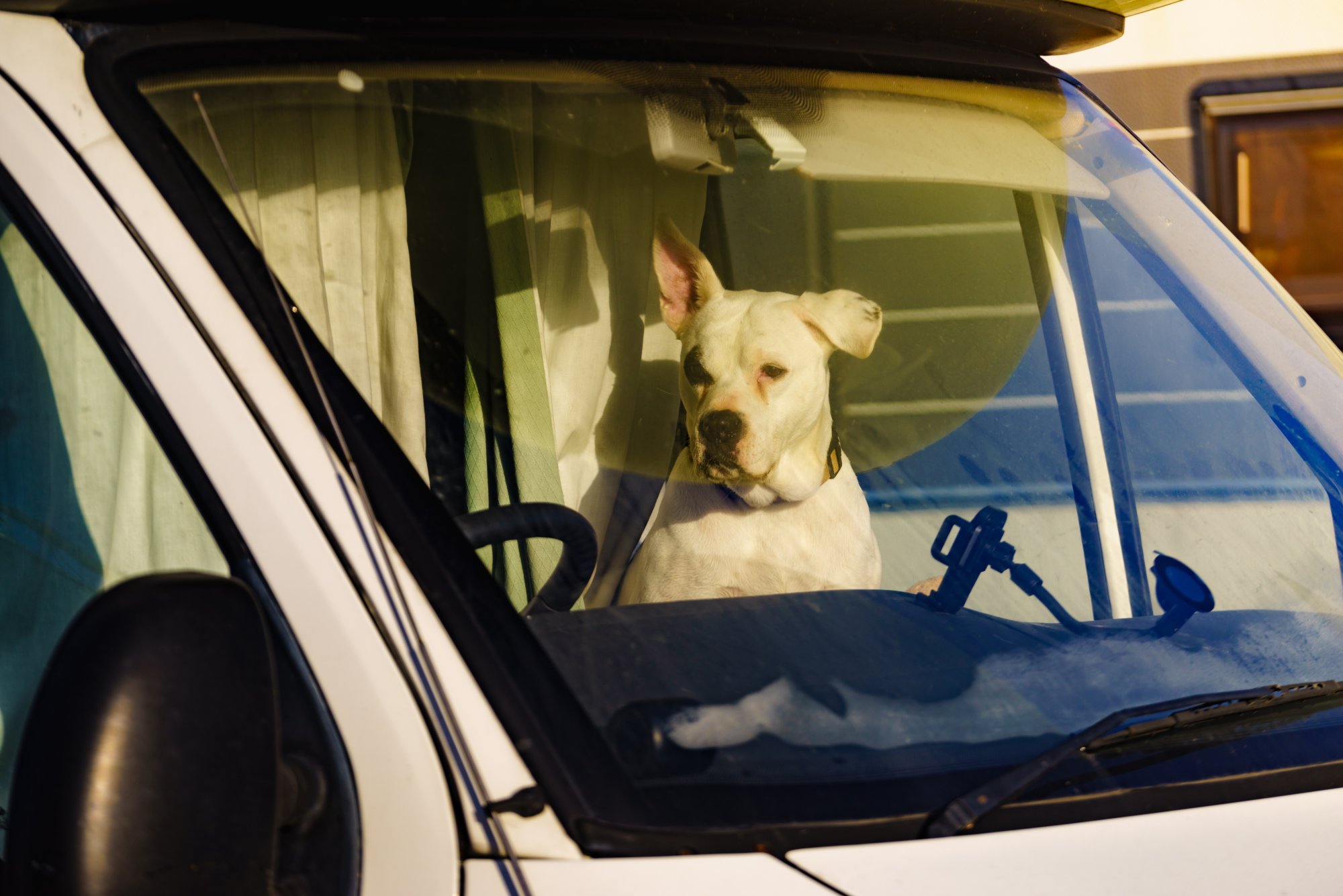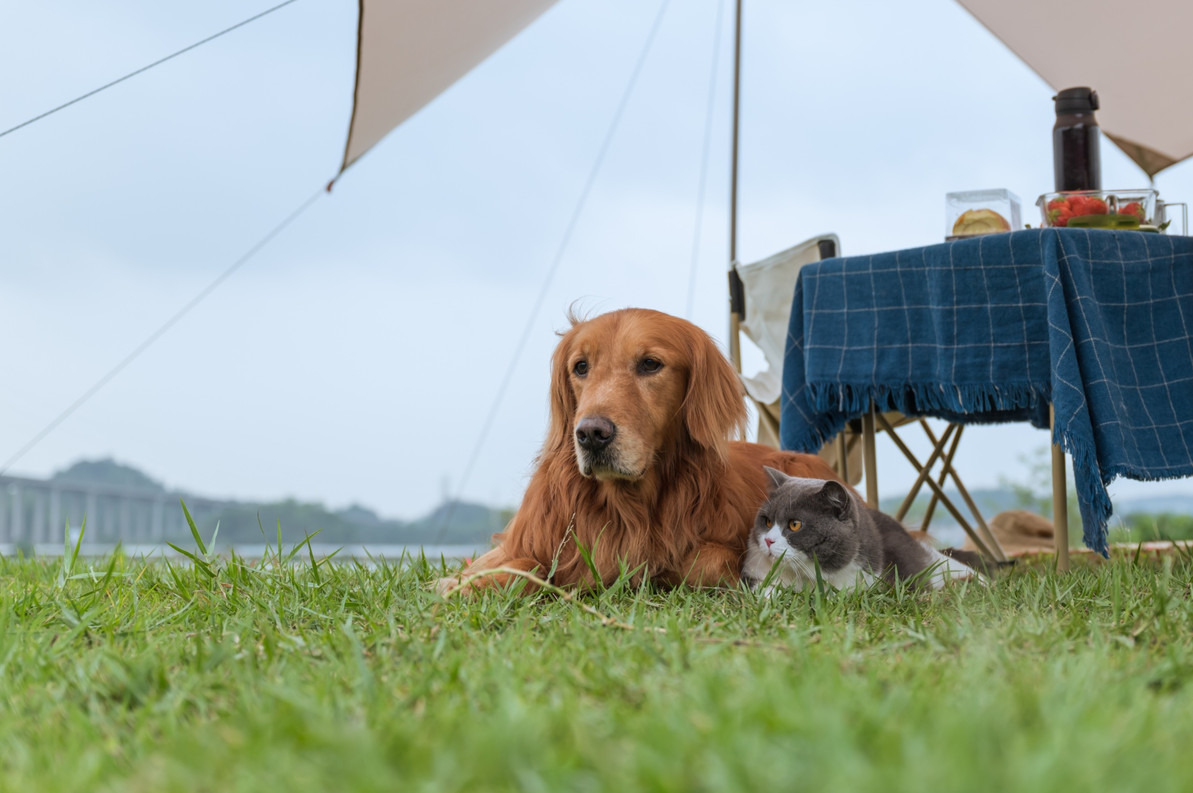How to Keep Your Pets Safe While Camping
RVing and camping are a great getaway from the hustle and bustle of work and the city and the day-to-day. It can be a great way to relax and reconnect with nature. As an added bonus, a camping trip makes it easier to take your four legged companions along.
Traveling with your pet can be of great value. You don’t have to worry about how they will do at a boarding place (and you can avoid finding a good one and paying for the stay). Plus, taking them with you can develop your bond with them and grow their socialization with other people and dogs. Not only that, but it can be great for not just their health but yours as well. But as with all things, taking an extra companion with you in your RV requires a little bit of work to make sure it works out.
Prep

Prepping can be the best thing to make your overall camping experience with your four legged friends the best it can be. There’s a few key things to check off your list before you hit the road.
The first thing to prepare is your pet. You want to make sure that they will be able to handle a new area with minimal stress. If your pet is weary or scared of new people or environments, you may need to work your way up to a trip with them. But if your pet has been socialized and does well in new places, then they’re travel worthy, but there's a few more things to checkoff before you set off.
Research
First is making sure that the campground you’re staying at is pet friendly. Look into their pet policies so that when you arrive, you know exactly what you need to do for your pet and where you and your pet are allowed to go at the campground. Some pet friendly campgrounds, like KOA, even have off leash runs so your dogs can have a little freedom and fun with other dogs while you relax and watch.
You shouldn’t check just the campground but anywhere you plan to take your pet. If you’re wanting to take them to a beach or on a hike, you’ll want to make sure that they’re allowed to be there. Know the policy of any place you may want to take your pet so that you can be assured that the trip itself will run smoothly. You may also find it handy to locate the nearest emergency vet or walk-in vet clinic should an emergency arise.
Plan a Trip to the Vet

While going to the vet may not be necessary, it is best to check their records and print a copy to have on you just in case. Make sure your pet is up to date on their vaccinations, especially ones for communicable diseases. Besides looking for their rabies to be current, good vaccines for dogs to have to go camping are DHPP, Bordetella, Influenza, and Leptospirosis. These vaccines cover things that your dog can pick up from wildlife or other dogs.
While checking records, making sure your dog is microchipped can help if the worst happens and they manage to get loose. Microchipping keeps your information tied to your pet in a way that can’t be lost the way a collar can. If your pet is already microchipped, make sure your registered information tied to the chip is current and accurate. You also want to check if your pet may need a flea and tick treatment as those are going to be more likely to be a problem out in nature.
Another appointment you can make to help your pet on the camping trip is one to the groomer. It may seem like an odd thing to do before going on a trip, but it can help your pet from tearing a nail or overheating, especially if you have pets with thicker coats. Fur can get trapped in the undercoat if not properly brushed out and this can cause heat to dissipate from the body less effectively, leading to possible heat sickness. Taking a brush along can also be a good thing to keep up with shedding hair and possible knots that may develop.
What to Pack

There are a few things you want to make sure you take with you to make sure your pet is comfortable on the trip. You of course want to make sure you have plenty of food and treats and access to clean water, whether that's from a water tank or a water supply at the campground or bottled water. And as always when going anywhere with your pet, waste bags or litter trays are a must. Another basic necessity is to make sure you have your pet's collar and/harness and leash. If your leash has seen better days, now may be the time to invest in a new sturdy one. In addition, adding a reflective collar or even just a glowstick at night can help increase your pet’s visibility.
You also want to make sure they have up-to-date tags on their collars so if they happen to get loose, people can use the right information to find you. A temporary ID that has your campsite number may also be useful to take if cell reception is spotty where you’re staying. A temporary ID can be as simple as wrapping a piece of tape around their collar and writing the site number on it with a permanent marker, that way you can remove it when you leave and change it if you go to a new campsite and have a new campsite number to use.
Besides the basics, there are plenty of other things you can take that can make your trip better and make sure your pet is comfortable. A pet first aid kit is a great thing to have, especially if you are rather active with your pet. RecPro offers a compact, but comprehensive pet first aid kit. Among the basic first aid pieces you would carry for humans, you want to make sure you have at least a thermometer to check your pet’s temperature if they exhibit any signs of overheating.

You should also take a current photo of your pet and print it out so you have a physical copy to show people should your pet get loose. When temperatures are particularly extreme, both cold and hot, be sure to keep an eye on your pets paws. They’re incredibly sensitive and extreme weather can harm their pads. A good rule of thumb is if you can’t hold the back of your hand to a surface then your pet shouldn’t be walking on it. Blacktops get extremely hot in direct sunlight and this can lead to blisters on paws. Salt used for sidewalks can also be harmful to paws so take caution walking in winter as well.
A good way to protect their paws is to invest in a set of booties, or even socks. These work in both weather extremes and can keep your pet's paws safe and clean. They may take some time to get used to, so you may want to go on a few walks before your trip to get them used to wearing and walking in them. A good paw balm can also help keep pads soft and crack free. For older or smaller pets, you can invest in a pet backpack, pet stroller, or collapsible wagon to help them if they get tired on a hike or have trouble walking.
At the Campground

All your prep should have you mostly set to just enjoy your camping trip with your pet. But there are a few things to keep in mind while you’re at the campground. You always want to keep an eye on your pet. Watch that they’re not eating things that are harmful to them or drinking out of puddles. Keeping a close eye on your pet can also let you see the signs of heat exhaustion faster. Symptoms to look for are excessive panting, drooling, presenting with weakness or restlessness, disorientation. A full list of symptoms for dogs can be found here and for cats here.
This is where the thermometer comes in handy. If you notice symptoms in your pet, you can take their temperature and more easily manage it if it is too high. A temperature of 103°F or 104°F means they are overheated and need to be cooled immediately. To cool them, move them to a shady spot, or air conditioning if possible. Give them cold water, but make sure they don’t drink too quickly as drinking too quickly can also be harmful. Give them a cool bath or apply a wrapped ice pack or cold cloth to their belly. Retake their temperature after 15 minutes and if it hasn’t started to go down then take them to an emergency vet because it could be turning into heat stroke.
When camping, be sure to take the weather into consideration. If it’s going to be hot, be sure to plan cool places for your pet to cool off and relax in. With an RV or camper, this can be easy as you have easy access to AC. If you leave your pet in your camper, be sure the AC is on and that it won’t shut off while you’re away. A vehicle left in 85°F weather in the sun will increase in internal temperature to about 119°F over the course of just 30 minutes. It is never a good idea to leave a pet in a vehicle that does not have running AC.

If you’re tent camping, it can be a little harder to keep your pet cool, but it is still easily done. Make sure you have a shady spot for your pet to cool off. A battery powered fan can also be useful in the tent for creating air circulation and getting a breeze going. A cooling pad is also a good way to help keep your pet cool that requires no power and no freezing to work. Just lay it in a shady spot and your pet can lie on it and be cool.
Sit Back and Relax
To make your trip with your four legged friend the best it can be only requires a little planning. But once you’ve got it all figured out, you can sit back, relax, and enjoy their companionship on the road. A camping trip with your pet can make for great memories and for a wonderful bonding experience. And it can lead you to making new friendships with people and their pets as well.
Recent Posts
-
Traveling to the RV Hall of Fame in Elkhart, IN
If you are traveling to Elkhart, IN to see the RV Hall of Fame, getting off the toll road at exit 96 …Nov 14, 2025 -
Best RV Air Conditioners of 2025: An Expert Guide From RecPro
Quick Answers Best overall RV air conditioner: RecPro 15K Quiet AC with Heat Pump (RP-AC3800) Best f …Oct 29, 2025 -
The Nuclear Nomads Expand Sofa with New Recliner Section Install
The Nuclear Nomads are a full time RV family living in south Florida. Andi and Joey value quality ti …Oct 24, 2025 -
Trailer Wiring Guide: How to Wire Your Trailer for Safety and Efficiency
Table of Contents 1. Common Types of Trailer Connectors 2. Trailer Wiring Diagrams: Color Codes and …Aug 20, 2024 -
How to Keep Your Pets Safe While Camping
RVing and camping are a great getaway from the hustle and bustle of work and the city and the day-to …Jul 02, 2024 -
Why Replace Your RV Furniture?
You may wonder when is the best time to replace your RV furniture. There is no one right answer to t …May 20, 2024







